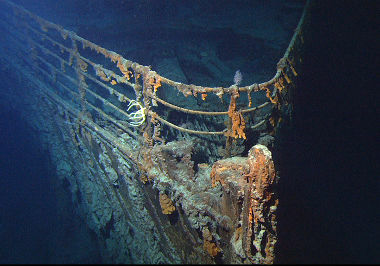On September 1, 1985, after a long search, the wreckage of one of the most famous shipwrecks in history was discovered: the RMS Titanic, well-known not only for James Cameron's 1998 film adaptation of the story, but for the worldwide shock and upheaval generated by the incident in 1912. Altogether, there have already been around 20 adaptations of the episode into films, all seeking to portray one of the most memorable episodes in the history of navigation.
The Titanic was a transatlantic ship belonging to the Olympic class and operated by the company White Star Line, a UK shipping company. The ship was built in Northern Ireland, in the city of Belfast, starting in 1909, and began its journey at Southampton Pier on April 10, 1912.
The vehicle weighed more than 45 thousand tons (one of the largest of its time) and carried 3295 people, including passengers and crew. The wreck happened in Atlantic Ocean, in the early hours of April 15, 1912, when he was heading to New York City. Altogether, there were only about 705 survivors.
The precise location of the sinking was at the geographic coordinates of 41°43′57″N latitude and 49°56′49″W longitude, about 840 km from the island of Newfoundland, Canada, the closest point. The ship, at the time of sinking, was about 1783 km from its final destination, on what was its maiden voyage.
Since the event, many search teams have been mobilized to find the wreckage of the ship. With the outbreak of the First World War, two years after the accident, the impacts of the conflict and the many shipwrecks during the fighting relatively overshadowed the issue in the collective imagination, but many continued with the objective of finding the remains of the luxurious vessel.
Despite many efforts, the technology of the time was insufficient to find an object at such a great depth. In the year 1929, it was even considered the hypothesis that the ship had been definitively buried by the sediments located in the seabed after the occurrence of a large earthquake in a relatively close region, which is now known to have occurred 600 km from the local.
Over time, several expeditions were carried out with teams specialized in this type of operation, many financed by millionaires or private companies in general, mainly during the 1950s, 60s and 70. Even so, the search results were completely fruitless. On September 1, 1985, 73 years after the sinking, a team led by oceanographers Jean-louis Michel and Robert Ballard finally found the Titanic's wreckage.

Titanic bow wreckage image
It is no accident that most searches were unsuccessful. The remains of the ship were found at a depth of 3800 m, where sunlight does not reach, and at a crushing pressure of 425 kg per cm², making the site impossible to access without the use of a submarine. At the time of the discovery, the main revelation was the fact that the ship had broken in two during the sinking, differently than previously thought, despite the various testimonies of survivors who claimed to have seen the vessel divided into two parts.
The place, over time, was the subject of much research and analysis. Many of them allowed the production of theories about the wreck sequences, all of them portrayed in visual compilations, among which the most awarded was the film starring in 1998. Likewise, the wreckage started to be used as a tourist spot, receiving several visits. It is worth remembering that no body has ever been found due to the high salinity, the action of microorganisms and the time elapsed since the tragedy.
In an article for the magazine National Geographic, in 2004, one of the oceanographers responsible for the discovery, Robert Ballard, expressed his dissatisfaction with the violations and disrespect practiced against the memory of a historical episode. In response to the requests of many who valued material conservation and respect for the incident that occurred, the Titanic's wreckage was protected by Unesco as of April 2012, 100 years after the wreck.
Currently, a site visit includes taking a cruise out of Canada and lasting 12 days, including diving in a submarine. None of the heritage can be violated, although it was violated several times after the discovery. The tour costs around US$ 60 thousand, including lodging and food.
By Me. Rodolfo Alves Pena
Source: Brazil School - https://brasilescola.uol.com.br/datas-comemorativas/destrocos-titanic.htm



